12 To-Dos When You’re Outdoor Kitchen Planning
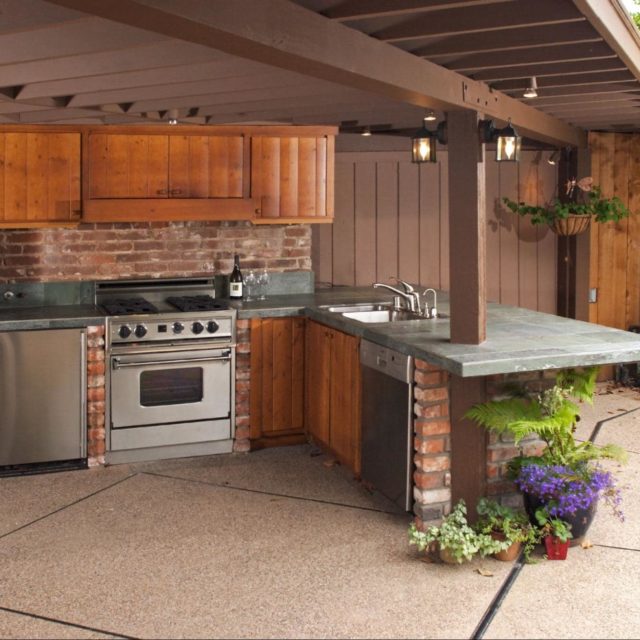
- Written by: jlbmdev

The possibilities and benefits of an outdoor kitchen are seemingly endless. You can add on a grill, turn your dining area into a full-on cooking station, or create a completely separate space for entertaining your guests and making delicious meals. No matter how you decide to go about planning for an outdoor kitchen, a few core outdoor kitchen components are universal to any build.
From budget to location, layout, and functionality, this outdoor kitchen planning guide will cover 12 tips every homeowner should keep in mind when looking to upgrade their outdoor space.
The best backyard cooking center for your home depends on several factors, including your budget, lifestyle, and available space, all of which we’ll cover below. But before all of that, it’s helpful to think of what type or style of outdoor kitchen construction you’re looking for.
Decide if you want a fully functional outdoor kitchen or a simple setup with a grill and a few comfortable chairs to entertain. From there, you can determine what is essential and what’s an amenity.
Tip: consider keeping your outdoor kitchen design in line with the aesthetic of the rest of your home. Think about your home’s current design — contemporary, modern, rustic, etc, and try to match the outdoor kitchen trend you’re considering to your home’s current look. With that said, keep in mind the kitchen will be outside — nature doesn’t need to be overly complicated.
Every major remodeling project should start with a budget. A well-defined budget will help you stay within your means and save you money by preventing impulse purchases that won’t ultimately make sense with the overall design.
Start with a rough estimate of how much you’re willing or able to spend on design, materials, and outdoor kitchen appliances. Your choice of appliances and materials will affect how much an outdoor kitchen costs. Typically, an outdoor kitchen will cost anywhere from $1,000 to $100,000 to build.
That’s a big range, so we suggest using the following guidance. A general rule of thumb is to spend no more than 10 to 15% of your home’s value on a single remodel. If your home is worth $300,000, this means a reasonable, fully-functional outdoor kitchen could be around $30,000.
What’s a good size for an outdoor kitchen? Generally, a kitchen should be about 20% of your overall deck or patio area. For example, if you have a 100-square-foot patio, then 20 square feet would be a good size for your kitchen.
You also want to keep enough room around all sides and corners for people to move around comfortably while you’re entertaining. You don’t want your outdoor kitchen to completely overtake your deck or patio. Instead, you want it to compliment it.
Remember that appliances, depending on the type you choose, can take up a fair amount of space. A general recommendation is to keep three feet of room on each side of your barbecue pit (should you have one) and two feet between stoves or other major appliances.
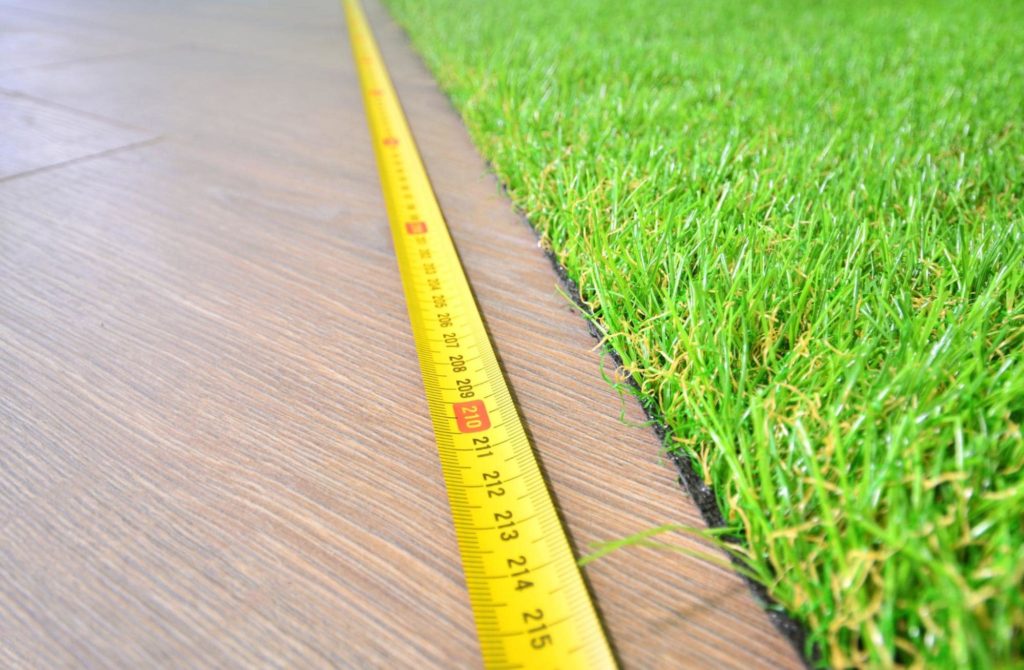
An outdoor kitchen can be a beautiful extension to your home. It can provide you with a place to entertain guests or simply enjoy a nice cup of coffee on a slow Saturday morning. But before you think about what you need in an outdoor kitchen, you first need to lay out where on your property it will go.
Not only should you plan for how it looks, but also how much room it needs, whether or not there is power nearby, and what materials you’ll use. In fact, electrical work and building materials will make up the bulk of your outdoor kitchen costs.
Remember, outdoor kitchens aren’t just about cooking, they’re also for entertaining. The location of your outdoor kitchen is a big factor in determining what style you want and how you want it to function. Can you build an outdoor kitchen on a deck? Absolutely! You’ll just need to first assess its load-bearing capacity, then consider how electricity and drainage utilities will be connected.
If you have room, an outdoor kitchen can offer more space for cooking and larger prep areas with countertops that aren’t just there for show. If space is at a premium, an outdoor kitchen doesn’t need to take up too much room as long as the design is well thought out.
No outdoor cooking kitchen is complete without high-quality equipment. Start first with a grill, and then you can think about adding a smoker or even a fryer. Fire pits, stoves, and heaters may also be added to your outdoor kitchen area if you’re looking for a way to keep your patio warm during the colder months.
When planning for a fully functional outdoor kitchen, you also want to remember to add a small refrigerator, sinks, water faucets, and outdoor lighting. Plan with a designer and a contractor to think about how you want your outdoor kitchen space to function before diving into the construction.
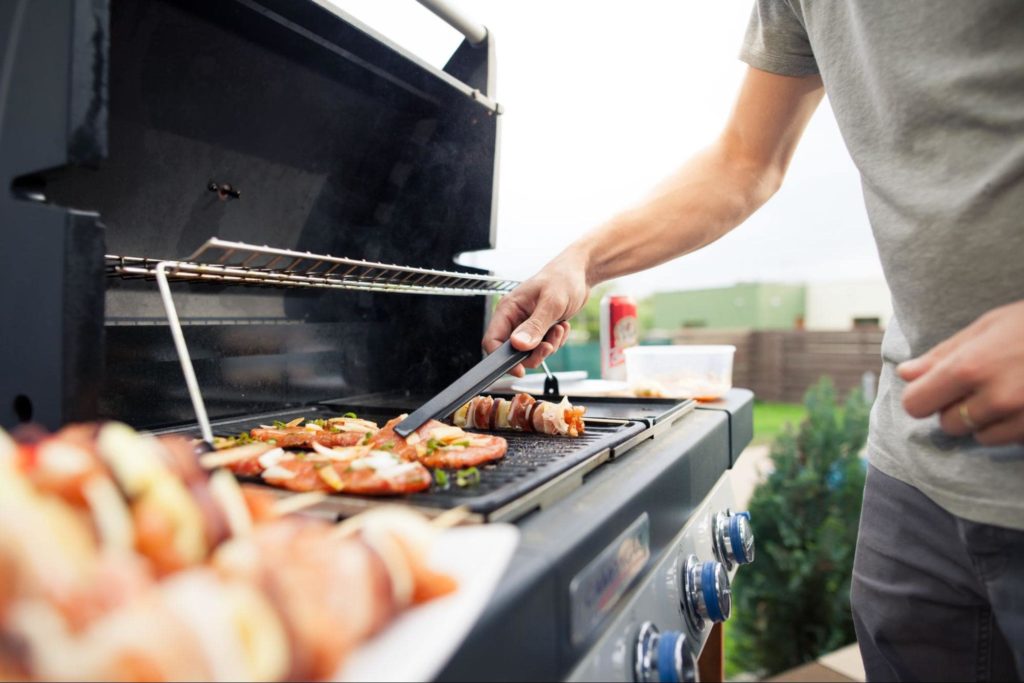
Do you need a permit to build an outdoor kitchen? While you may not need one (depending on your local building codes), it’s a good idea to get one anyway.
It’s always better to be safe than sorry, and if a third party is injured while using your outdoor kitchen, a permit can help protect you legally. Doing your due diligence to get a permit will ensure you won’t be liable if someone accidentally touches your propane grill or trips on a stair — even if it was their fault.
It’s also a good idea to keep a fire extinguisher nearby. From 2014 to 2018, the National Fire Protection Association (NFPA) reports U.S. fire departments responded to approximately 172,900 home structure fires per year started by cooking activities. They also reported an estimated $1 billion in direct property damage sustained each year from these cooking-related fires.
When planning for an outdoor kitchen, don’t forget the basics — like where to sit! If you want your kitchen to serve as a functional part of your home, you need to consider functional furniture. If you only have room for two or three chairs around your island, that’s okay. They don’t have to be elaborate, but they do need to be comfortable.
You also don’t necessarily need chairs on both sides of an outdoor island, either. A chair on one side and countertop space on the other makes for a nice flow in between your cooking and entertaining areas, creating a transition from inside to outside without taking up too much real estate. Whatever you choose, just be sure to pick high-quality outdoor furniture that doesn’t mind a little rain (or even snow).
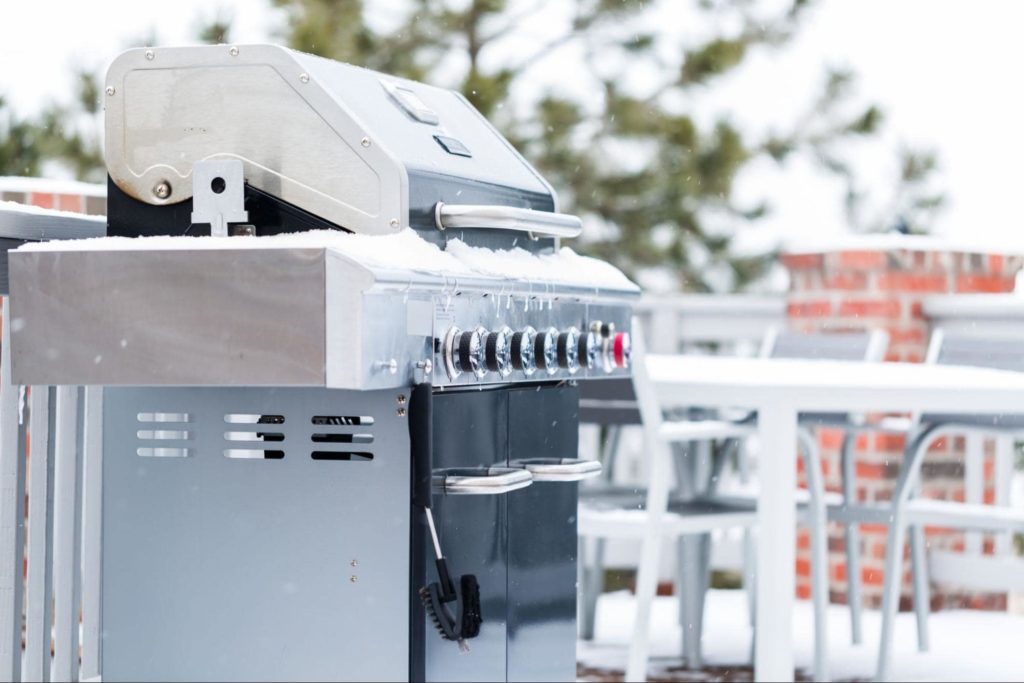
If you’re planning for your outdoor kitchen to function as an entertaining area into the late fall and winter months, you want to be sure you plan for cold weather. Heat lamps and fire pits are a great way to add some ambiance to your outdoor kitchen and keep your company from shivering when the temperature drops.
Heat lamps are a simple option for someone looking to flip a switch and warm things up. You’ll just have to remember to fasten them down or bring them inside if you’re experiencing heavy winds. For a more rustic feel, a fire pit is a classic option. From elaborate stone designs to portable and easy-to-use fire pits, bringing the campfire to your backyard is simple and affordable.
There’s no shortage of lighting choices for an outdoor kitchen. A few popular options to consider include:
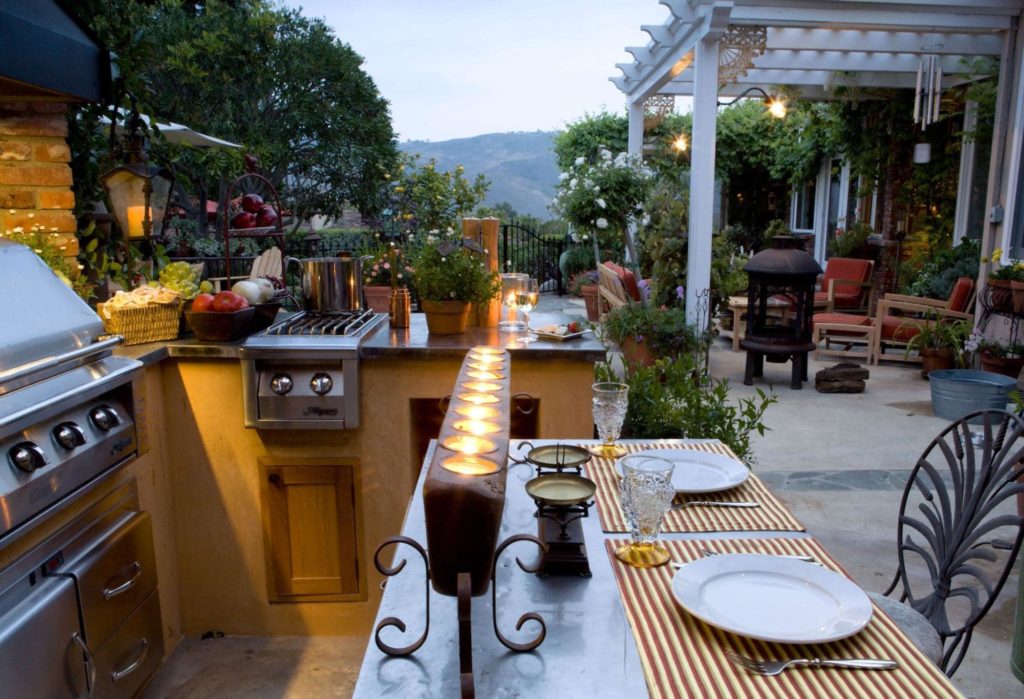
The perfect outdoor kitchen isn’t complete without a structure to keep you safe from the elements. From pergolas to pavilions and gazebos, the right outdoor structure can spruce up your outdoor kitchen, adding style and functionality.
When choosing an outdoor structure, be sure to keep style and maintenance in mind. High-quality wood structures look great and will last a long time, but if you’re someone who doesn’t want to deal with any upkeep at all, opting for a vinyl structure may be your best bet.
Cutting corners on things like clothes or cleaning supplies and going for the least expensive option isn’t that big of a deal. But when it comes to a major project, saving money in the here and now by purchasing cheap, low-quality materials can cost you a lot in the future.
Whatever you choose — from appliances to countertops and cabinets — one of the most important elements to keep in mind is to make sure all the materials are made to last. While high-quality materials are important in any kitchen, the extra wear and tear your outdoor kitchen will endure — simply from being outside — make it all the more important to prioritize quality.
You shouldn’t have to burn that perfect piece of ribeye because you were distracted searching for your cooking utensils. Organize your grill space with room for cookware, utensils, and gadgets by adding conventional storage options like shelves and cabinets.
Make sure your cold storage equipment is suitable for storing meat, poultry, fish, fruits and vegetables, and chilled beverages. You can store items at optimal temperatures even outdoors by using under-counter refrigerators and freezers.
Illegitimate contractors are more common than some may think. Never partner with an unlicensed contractor, or with someone requiring a large deposit upfront. At J&L, we help people find trusted contractors for any project, so you can rest assured you’re getting the best work at the best possible price. For more on working with contractors, read our blog on how to hire a contractor.
According to most experts, a homeowner with a high-quality outdoor kitchen installation will at least break even on the project when they sell their homes. HFS Financial states that outdoor kitchens can even provide a return on investment (ROI) between 100% and 200%.
In short, an outdoor kitchen can increase both quality of life and resale value, as the outdoors are scientifically proven to increase mental energy and reduce stress levels, and an outdoor kitchen is shown to yield an impressive ROI.